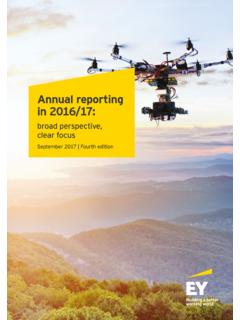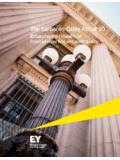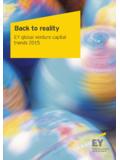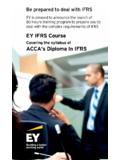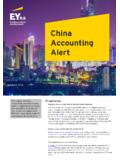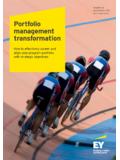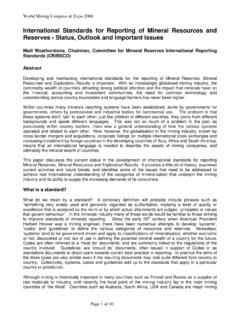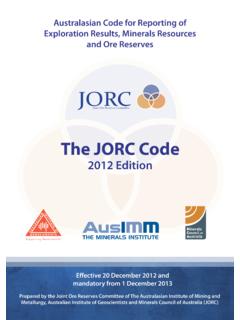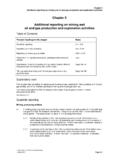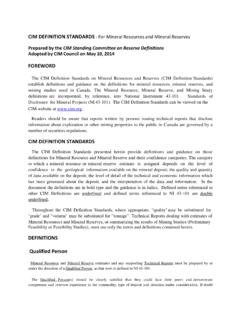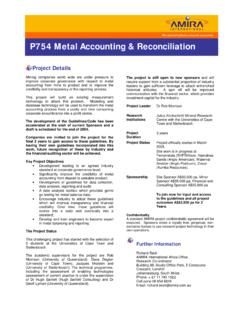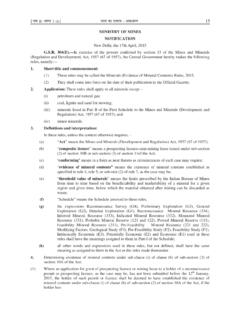Transcription of Are you ready for conflict minerals reporting? - United States
1 Are you ready for conflict minerals reporting ?Insights for US reporters and their suppliersBy 31 May 2014, all SEC registrants that use conflict minerals in their manufactured products will need to disclose whether these minerals originated from the Democratic Republic of the Congo or any of its neighboring countries. If the minerals do originate from any of these countries, SEC registrants will need to report on whether the sourcing of these minerals could have provided funding to armed many SEC registrants are far removed from the source of their minerals , they are reliant on companies in their supply chain to provide timely and accurate information to enable September 2013, EY held a webcast attended by 268 global clients a mix of SEC registrants and suppliers. This paper provides a snapshot of the challenges these businesses face in the run-up to the first reporting deadline of 31 May 2014 and sets out recommendations for overcoming these you need to know Regardless of whether you are an SEC registrant or a supplier, companies need to establish a clear strategy for compliance, secure buy-in from leadership and relevant business functions, and ensure sufficient resources for delivery.
2 Currently, less than half of companies feel they are on track to meet their compliance objectives, with the majority either unprepared, still interpreting the impact of the legislation or in the early stages of planning. For suppliers that are not ready to respond, there is the risk that reactive or ineffective responses to information requests could strain commercial relationships with key customers. For SEC registrants, slow responses to information requests, as well as incomplete or unreliable data, will increase compliance costs and could create risks of SEC sanctions and reputational damage. SEC registrants are anticipating an intense period of supplier engagement in the next six months. One-third of companies said this activity is their most critical immediate need. Companies outside the US are less advanced in their preparations for conflict minerals reporting than their US-based peers.
3 Importantly, there is a disconnect between the recognition of the importance of supply chain engagement and the readiness of companies in the supply chain to provide the information needed for reporting . While the SEC rule allows for a level of certainty about mineral origins in the first two reporting years, this is not a free pass and should not detract from the sense of urgency needed to achieve regulatory compliance. For companies that set up their conflict minerals programs in the right way, there are broader business benefits to be realized. These include improved risk management, enhanced relationships with customers and suppliers, and readiness for other similar emerging disclosure the conflict minerals rule The SEC s conflict minerals rule is complex, but in essence it requires SEC registrants to respond to three key questions:1. Do your manufactured products contain conflict minerals ?
4 2. If yes, could the minerals have come from the Democratic Republic of the Congo (DRC) or its adjoining countries?3. If yes, did the mining of these minerals provide funding for armed groups?STEP 2 Reasonable Country of Origin Inquiry (RCOI) STEP 3 Due diligenceSTEP 1 Applicability assessmentKey considerations Potential implicationsNo action required Might the minerals come from the DRC region? Did the mining activities fund armed groups? Move to step 2 File Form SD onlyYes move to step 3 conflict free NoYesNot conflict free UndeterminableAssurancerequired No assurance Do we sell products that we manufacture and that contain conflict minerals that are important to the product? NoYesNo?YesContinued from page 1 ..Are you ready for conflict minerals reporting ?2 Preparing for conflict minerals disclosure Planning and organization Engage with senior management: the first step for the individuals tasked with establishing a company s conflict minerals program is to engage with senior leadership to gain executive sponsorship.
5 This is necessary to ensure cooperation across the business to deliver the program. It should also assist in the next step, which is the creation of a cross-functional team to include procurement, compliance, product development, production, finance and other business areas as necessary. Establish governance processes: the team needs to set up clear governance processes that specify how the team is going to work, its priorities, and how the organization will deal with the findings of the compliance program. This will also help develop an understanding of the scope and scale of the program. Formulate a project plan: a strong project plan, including milestones, workstreams and training, is critical in enabling compliance deadlines to be met. For SEC registrants the first reporting deadline is 31 May 2014, and annually thereafter. For suppliers the reporting deadlines will be specified by customers (but will be earlier than the SEC deadlines).
6 Create a communications strategy: a clear communications program should be part of this plan. This will include establishing an organizational conflict minerals policy and communicating this and other messages about the program to suppliers, customers and internal Country of Origin Inquiry If conflict minerals are used in an organization s manufactured products (regardless of the quantity of these minerals there is no de minimis threshold in the rule), then companies will need to perform a Reasonable Country of Origin Inquiry (RCOI) to establish the source of these conflict is important to have an effective strategy for analyzing the product and supplier base in order to efficiently and effectively prioritize RCOI efforts. For many companies this can be a daunting task given the prevalence of conflict minerals in the product supply chain of many manufacturing sectors.
7 Typical approaches to prioritization include segmenting the product and supplier base by procurement spend or volume to ensure that RCOI efforts are focused on the most relevant elements of the supply these inquiries, suppliers will need to communicate details of the countries from which conflict minerals have been sourced to their SEC registrant customers. For SEC registrants, if the RCOI inquiries lead the registrant to believe that none of its conflict minerals could have originated from the DRC region, then a limited Form SD disclosure needs to be prepared and filed with the SEC, outlining how this conclusion was , if the RCOI inquiry establishes that the conflict minerals may have originated from the DRC region then SEC registrants, and consequently their suppliers, will need to perform more detailed due diligence to establish whether the sourcing of these minerals could have provided funding for armed diligence SEC registrants are required to disclose the results of due diligence in a conflict minerals Report, which may ultimately require independent assurance.
8 This would focus on whether the company s due diligence process has been designed in accordance with the conflict minerals due diligence framework developed by the Organisation for Economic Co-operation and Development (OECD), and whether the due diligence process has been implemented as to SEC registrants may not be subject to the same reporting and assurance requirements as registrants; however, some SEC registrants are likely to seek assurance from their suppliers on how due diligence has been enacted down the supply chain. Where companies cannot determine the source of the minerals and whether proceeds from mining activities fund armed groups, SEC registrants are able to file an undeterminable status. This is available to large SEC registrant companies for the first two years, and to smaller registrants for four years. However, this is not a free pass. For many companies, it will take a significant amount of time for reliable information on conflict minerals sourcing to be reported up the supply chain.
9 SEC registrants that still have undeterminable minerals in their supply chain after the grace period must publicly disclose the relevant products as not found to be DRC conflict -free and obtain an independent audit over their due diligence you ready for conflict minerals reporting ?Compliance deadlines loom, but many are unprepared Less than half (41%) of the companies participating in the webcast felt that they were on track to meet their compliance objectives. The remaining 59% were either unprepared, still in the process of interpreting the impact of the legislation, or in the early stages of planning their compliance activities. Indications are that currently US companies (whether SEC registrants or their suppliers) are more advanced in their preparations for compliance than their non-US statement best describes your organization s current state of conflict minerals readiness?
10 0%5%10%10%28%21%41%15%20%25%30%35%40%45% RespondentsA. Your business is unpreparedB. We are starting to understand the scale of the issueC. We are assembling a team and planning our responseD. We are on track to meet our compliance objectivesThose companies at the more advanced stage, who have completed rule interpretation, impact assessment and planning, will drive a shift in the market to an intense period of supplier engagement in the next six months. Thirty-three percent of companies expect to focus on supplier engagement as the most critical immediate need in their compliance program. What is the most critical immediate need in your business?0%5%10%15%20%25%30%35%27%21%33% 11%8%A. Understanding how the legislation impacts my businessB. Engaging senior leadership teamC. Developing a clear strategy and planD. Supply chain engagement/RCOIE. Secure necessary resources including technologyRespondentsAlmost 70% of companies anticipate the most intense period of supplier engagement will be between now and March 2014.
